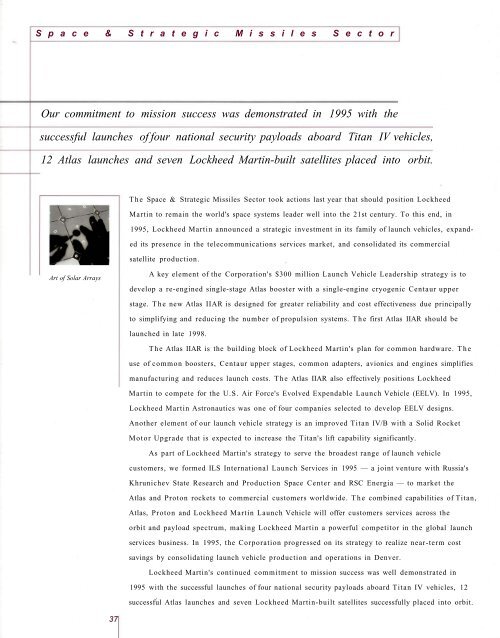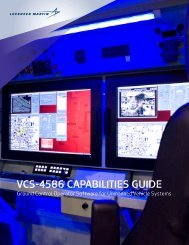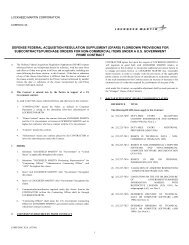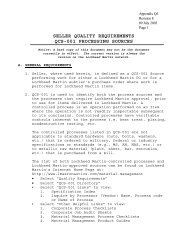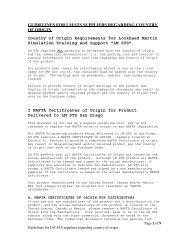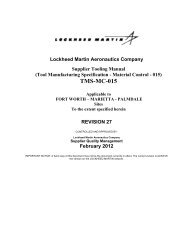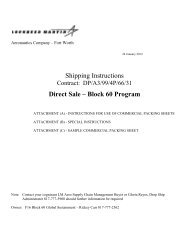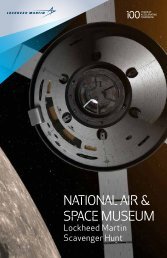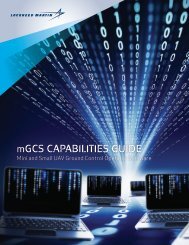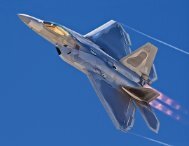1995 Annual Report - Lockheed Martin
1995 Annual Report - Lockheed Martin
1995 Annual Report - Lockheed Martin
You also want an ePaper? Increase the reach of your titles
YUMPU automatically turns print PDFs into web optimized ePapers that Google loves.
S p a c e & S t r a t e g i c M i s s i l e s S e c t o rOur commitment to mission success was demonstrated in <strong>1995</strong> with thesuccessful launches of four national security payloads aboard Titan IV vehicles,12 Atlas launches and seven <strong>Lockheed</strong> <strong>Martin</strong>-built satellites placed into orbit.The Space & Strategic Missiles Sector took actions last year that should position <strong>Lockheed</strong><strong>Martin</strong> to remain the world's space systems leader well into the 21st century. To this end, in<strong>1995</strong>, <strong>Lockheed</strong> <strong>Martin</strong> announced a strategic investment in its family of launch vehicles, expandedits presence in the telecommunications services market, and consolidated its commercialsatellite production.Art of Solar ArraysA key element of the Corporation's $300 million Launch Vehicle Leadership strategy is todevelop a re-engined single-stage Atlas booster with a single-engine cryogenic Centaur upperstage. The new Atlas IIAR is designed for greater reliability and cost effectiveness due principallyto simplifying and reducing the number of propulsion systems. The first Atlas IIAR should belaunched in late 1998.The Atlas IIAR is the building block of <strong>Lockheed</strong> <strong>Martin</strong>'s plan for common hardware. Theuse of common boosters, Centaur upper stages, common adapters, avionics and engines simplifiesmanufacturing and reduces launch costs. The Atlas IIAR also effectively positions <strong>Lockheed</strong><strong>Martin</strong> to compete for the U.S. Air Force's Evolved Expendable Launch Vehicle (EELV). In <strong>1995</strong>,<strong>Lockheed</strong> <strong>Martin</strong> Astronautics was one of four companies selected to develop EELV designs.Another element of our launch vehicle strategy is an improved Titan IV/B with a Solid RocketMotor Upgrade that is expected to increase the Titan's lift capability significantly.As part of <strong>Lockheed</strong> <strong>Martin</strong>'s strategy to serve the broadest range of launch vehiclecustomers, we formed ILS International Launch Services in <strong>1995</strong> — a joint venture with Russia'sKhrunichev State Research and Production Space Center and RSC Energia — to market theAtlas and Proton rockets to commercial customers worldwide. The combined capabilities of Titan,Atlas, Proton and <strong>Lockheed</strong> <strong>Martin</strong> Launch Vehicle will offer customers services across theorbit and payload spectrum, making <strong>Lockheed</strong> <strong>Martin</strong> a powerful competitor in the global launchservices business. In <strong>1995</strong>, the Corporation progressed on its strategy to realize near-term costsavings by consolidating launch vehicle production and operations in Denver.<strong>Lockheed</strong> <strong>Martin</strong>'s continued commitment to mission success was well demonstrated in<strong>1995</strong> with the successful launches of four national security payloads aboard Titan IV vehicles, 12successful Atlas launches and seven <strong>Lockheed</strong> <strong>Martin</strong>-built satellites successfully placed into orbit.37


